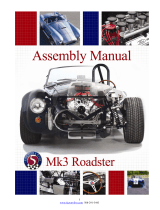
Installation Instructions cont. C3235 10-Pt Roll Cages Page 4 of 6
Now tack and weld completely around the trunk plate, be sure when welding to keep the heat from
welding within the mounting plate and not to the cars thinner sheet metal, this may structurally
weaken your welding points. Tack weld the rear struts in place.
12. With the driver seated, measure for the height of the main hoop harness bar. This is the tube that
mounts between the legs of the main hoop and supports the driver's seat in the event of impact. It
also acts as a structural member for the shoulder harness. Follow your sanctioning body's guideline
for correct placement.
a. Cut the un-notched end of the tube to the correct dimension taking into account the notch that
needs to be added to the end of the tube (typically 5/8" extra).
b. Trial fit the crossbrace and tack in place if the fit is correct. Make sure that the tube is level.
13. Now install the two forward downstruts. These tubes attach to the main hoop as close to the highest
part of the main hoop as possible. Their position has a direct relationship on the driver's visibility so
space them as far apart as possible and as close to the windshield posts as possible.Trim length
accordingly so that horizontal section contacts the main hoop.
a. Determine the location of the tubes and where they will meet the floor. Clean this area on the
floor and tack weld another set of 6" x 6" plates.
b. Trial fit the downstrut tubes to determine how much, if any, needs to be trimmed from the end of
the tube. Make sure that the notch fits properly and that you can weld the joint completely.
c. Tack weld the tubes in place. (Remove or completely isolate fuel lines under floor).
d. Position eyebrow bar at the intersection of the horizontal section and the angled section (pointing
toward the dashboard), making sure that the eyebrow bar does not obstruct the drivers view (see
diagram).
14. The next part of the installation is the main hoop supports. These tubes span from the intersection of
the main hoop and main harness crossbrace to the top of the rear frame rail near the front ladder bar
or 4-link brackets. These supports will improve chassis reaction time and make the car less flexible.
a. Determine the route for the tube. Make a template of the notch required on the ends of the tube
using a piece of paper wrapped around the end of the tube. Slide the paper up into the location
for the notch and mark the contours on the paper. Trim the paper as if it were the piece of tube
being notched. Refine the cut in the paper until your have a perfect fit. Transfer this shape to the
end of the main hoop supports.
b. Trial fit the tube to the car. Tack weld in place.
15. The last part of the roll cage to be installed is the door bars. The door bar spans from the main hoop
to the intersection of the front downstruts and the floor plate. Most sanctioning bodies require that
the door bar passes by the driver at a point between the shoulder and the elbow. The driver should
be seated in the car to properly locate the door bars. Follow your sanctioning body's guideline for
correct placement.
a. The front of the door bar is to be located at the bottom of the front downstrut where it meets the
floor plate. Notch and fit the front of the door bar so that it gets welded to both the floor plate and
the front downstrut.
b. Notch the back of the door bar to fit against the main hoop. Work slowly and carefully here,
mistakes happen easily on this type of notch.
c. When you are satisfied with the fit, tack weld the bar in place (remove or completely isolate fuel
lines under floor).
Installation Instructions cont. C3235 10-Pt Roll Cages Page 5 of 6












